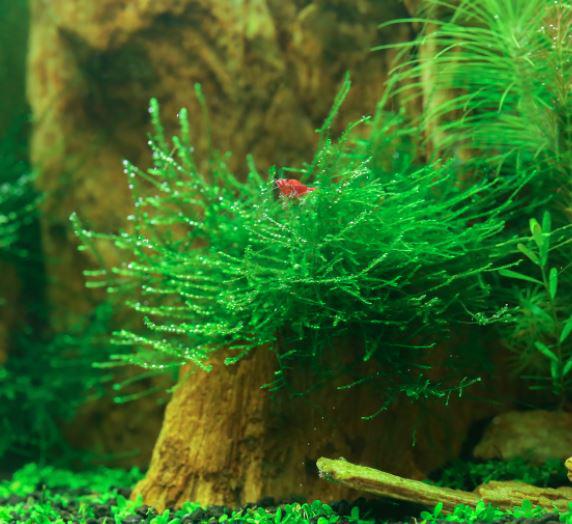Growing Java Moss
Considering adding a moss to your aquarium?
Perhaps you'd like to try your hand at some simple aquascaping with moss and driftwood. No doubt you've come across Java moss!
This plant is straightforward to maintain and requires very little care.
It tolerates a wide range of temperatures, does not require CO2 or excessive light. In addition, Java Moss has a great capacity to absorb some toxic elements, especially phosphorus.
The most likely problem you will face with Java moss is algae growth which can be extremely difficult to remove.
In most cases, it's best to start over and double check the your tank's water parameters and light levels.

Java moss is a very hardy plant that grows in most water types and can withstand wide variations in temperature and pH.
Ideal aquarium conditions include:
- slightly moving, slightly acidic water,
- low to medium hardness,
- temperatures between 69 to 75º F.
Under these conditions, you're going to get faster growth and a plant that looks closer to that found in its natural environment.

That being said, Java moss will tolerate temperatures up to 86 F, and hardness ranging from 3 to 12 with a pH of up to 8. That's quite a range!
The only thing to note here is that the growth rate will decrease with those extremes. You might also get a very different look to the plant with different parameters.

In terms of light, Java Moss will grow in either low or high light.
You will notice a difference depending on the lighting option you choose.
Low light makes a darker green, more slender plant, while high light will produce a denser, more compact plant.
If you grow your Java immersed, you'll also get a lighter green color with more tendency to 'Brown'. It's not dead or dying, that's just what java moss likes to look like in the better light and easier access to co2:

You can also add CO2 and fertilization to speed up growth rates, but this plant really doesn't need them and will grow just fine without it.
A word of caution on Co2 with Java moss; if your carbon concentration is too high in the water column, the moss can be plagued by filamentous algae.
Since its so difficult to remove, and almost no one succeeds, I'd recommend against Co2 entirely for Java. It's just too hard to balance.

Java Moss is a ridiculously hardy aquarium plant that is easy to transplant. You can split it up and place it in other places where you would like it to grow.
Just pull it apart and wad it up!
The propagation of Java Moss is equally straightforward; prune with scissors/ snips as the moss spreads, and use the segments cut to form new clumps.
This is a great way to get more and more moss growing for aquascaping! Use thin, clear sewing thread to attach to driftwood, rocks, decorations, Bonsai wood etc.

Java moss is suitable for almost all but the most high-tech aquariums.
It has endless uses, from providing aesthetic beauty to sheltering shrimp and fry.
It is effortless to grow and maintain, and perfect for beginners and experienced aquarists alike!
SUBSCRIBE FOR SALES,STOCK ANNOUNCEMENTS AND LATEST BLOG... DIRECTLY TO YOUR EMAIL!
- Choosing a selection results in a full page refresh.
- Press the space key then arrow keys to make a selection.
